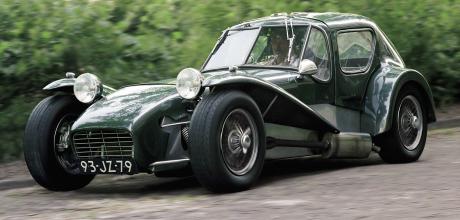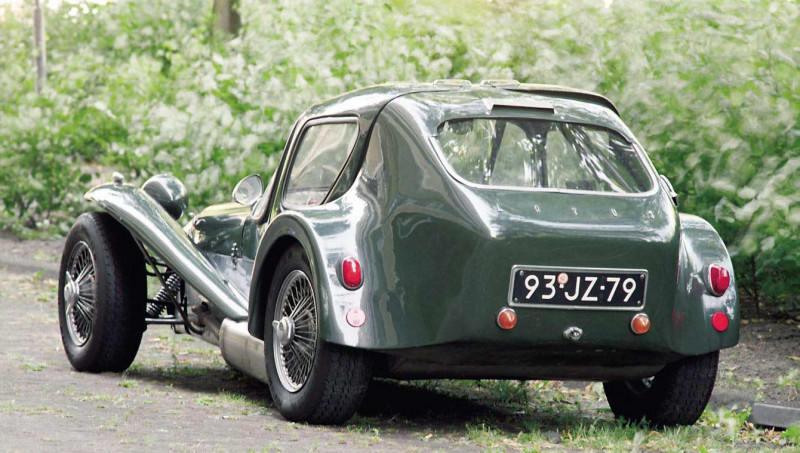1973 Lotus Seven GT

Case Closed Turning the Lotus Seven into a GT seemed a clever idea in the early 1960s. But the company behind it had to close its own doors soon after its launch. Words and pictures: Jeroen Booij.
PERIOD CONVERSION THAT MADE THE SEVEN INTO A GT… JUST!
The short-lived conversion that made the Seven eligible for GT racing, rarer now than ever.
Oh, those carefree early days of specials building. A clappedout, almost worthless saloon could be turned into the swoopy sports car of your dreams in a weekend. In the early ’60s, there was a beehive of small companies trying their luck. New names offering aerodynamic lightweight bonnets, hardtops, accessories or complete bodyshells popped up every week. These companies were often based in rudimentary workshops, smithies, sheds or old hangars, but if the men behind them were bright enough to come up with a good product of their own it could well be the springboard to something bigger. Everyone who wanted to become a serious player in the automotive world of those early ’60s looked up to some excellent role models: Colin Chapman, Trevor Wilkinson, Eric Broadley and Jem Marsh to name just a few. They had all started their careers in a shed.

One of those new names was Richard Seth- Smith. In what is now a one-bed leasehold flat in an area where you won’t find any property for under £2m, he set up Fibrepair Ltd. It was in 21a Lancaster Mews in Bayswater, London, with the plan to start repairing fibreglass car parts and making all sorts of accessories for enthusiasts. After an aerodynamic bonnet for the Austin- Healey Sprite, bucket seats were to become Fibrepair’s next specialisation. The little London based company came up with the Rallye 1 and Rallye 2 seats, which were soon to become a hit.
Seth-Smith’s right-hand man Mike Donegan was an avid racer in his Willment-tuned Ford Cortina, which he both rallied and raced rather successfully. Motor Sport magazine had a blast in it and wrote: ‘The very good Fibrepair seats play their part on bends for the wraparound sides hold the driver in position, while the excellent shape of the cushions makes for fatigue-free driving.’ Both Speedwell and Sprinzell began to market the range of Fibrepair Rallye seats under their own name, while Marcos Cars recommended them to their clients.

But Seth-Smith wanted more, so what was next? He came up with a clever idea after he’d noticed that the international motorsports association, the FIA, had begun to focus more on GT cars. This ruled out – among others – the very popular Lotus Seven. Seth-Smith began to wonder if the open Seven could be turned into a GT with a fibreglass roof construction to make it eligible for GT racing.
It seemed like a great opportunity and Fibrepair was the company to jump to it. But it may have seemed simpler than it turned out to be. The Seven is a small car, and fitting a roof and doors to it wouldn’t be at all straightforward. The new roof would have to be low while there was little space for doors behind the car’s long nose. If conventional doors were fitted, a Seven GT would have become a real agony to get into. And so Seth-Smith cleverly decided gullwing doors were the only option, similar to those of the Marcos ‘Wooden Wonder’ GT. He started sketching and applied to master coachbuilders Williams & Pritchard in North London for a prototype in aluminium.
Charlie Williams and Les Pritchard must have liked the idea. They had over 20 men working for them at the time and were known to be able to build a prototype from scratch in under a month. Up until then, they’d also built every single prototype for Lotus up to the Elan, which had just been launched. But after that model, the relationship with Lotus ended as the company set up its own bodyshop in 1962. Well, at least that meant it wouldn’t matter if Chapman and co objected to this project! The car that W&P used for the GT conversion was to become a very special Lotus, too. This particular Seven was purchased as a kit from Lotus Cars in 1961 by brewery magnate Richard Courage, and built up by his son, a budding racer, 20 years of age and about to enter motorsport. He was to become one of Britain’s most-loved Formula One drivers: Piers Courage. Young Piers raced the Lotus with its aluminium GT roof with gullwing doors at Brands Hatch on Boxing Day in 1962 and made the fastest practice lap in his class. Unfortunately he had to retire during the race due to malfunctioning spark plugs.
With fibreglass kits now moulded from the aluminium prototype, the Seven GT was ready to be marketed. The car was unveiled at the London Racing Car Show in January 1963, where Fibrepair shared a stand with Taurus Tuning and Interior Silent Travel – the latter based in the same London mews. From the Racing Car Show’s programme: ‘The Seven GT is a grand touring conversion on the Lotus Seven, making a completely closed car, while still retaining its excellent all-round visibility. Gullwing doors are utilised, which are asymmetrically disposed about the centre line allowing ease of entry for both occupants.’ And from the two-page flyer they handed out on the show: ‘The Seven GT is the answer to converting the Lotus Seven into a completely closed and weatherproof grand touring car.’
Fibrepair offered the conversion for £77 in standard Lotus colours. It came with a windscreen (of unknown origin; probably a rear screen from a more mundane model), side and rear screens in Perspex and all the necessary rubbers and fixings.
According to the manufacturer it would take anyone approximately a day to fit, although they could do it for you for an extra tenner.
As well as the asymmetrical gullwing doors, the whole GT conversion was rather clever. If the attraction to the original Seven was its simplicity, then it was this simplicity that helped turn it into a GT. With the original windscreen and scuttle, plus its rear bodywork removed, the new roof/ rear construction could indeed be fitted easily. The rear wings were retained and even the spare wheel, strapped to the back of the car, was still located in the very same place, now just covered by the fibreglass unit with its Perspex rear screen and just visible from the back. By 1963, hundreds of Sevens had been sold and a great number of them were raced at the weekends. Fibrepair was ready to sell its conversion in big numbers. The £77 asking price may not have been a giveaway when you consider that a Lotus Seven started at £499 at the time, but it was reasonable if you wanted to continue campaigning your Seven in competition. Or perhaps if you used yours throughout the year and were lured by the ‘weatherproof’ claims of the manufacturer.
It didn’t happen. Very few GT kits were sold and even fewer survive to this day. Piers Courage’s car was restored recently but as the roadster format it was conceived as in 1961. Most of the other GTs built eventually underwent the same fate. With its roof and gullwing doors, the GT was of course rather claustrophobic inside. And while the car’s original owner may have liked it, the next one perhaps did not.
It does make survivors extremely rare today. The green car seen here was exported from the UK to Holland in the 1970s. Remarkably, perhaps, it was based on a Seven S1 that was much modified, probably to give it a contemporary look, when the Fibrepair unit was fitted. The Dutch owner was a real Lotus enthusiast who imported a great number of Sevens to the low countries. He even became an agent for Caterham from as early as 1973 and started selling a wider Seven inspired car of his own design (the Bartan) in the early 1990s. His old Seven GT was restored later, keeping in faith with the Fibrepair conversion. Perhaps that was only logical, too, for the Seven’s rear wings had been merged into the Fibrepair roof/rear body unit, blending it even more into a GT car, but also making it not quite so easy to take off the conversion unit! It is one of perhaps just a handful of Seven GTs surviving today.
And Fibrepair? What happened to that? After the Seven GT adventure, Richard Seth- Smith’s company came up with a hardtop for the Triumph Spitfire at the Racing Car Show of 1964. Once again this conversion turned the roadster into a GT, now with a cool Kamm tail. It even predated Triumph’s own closed GT6 version by two and a half years! ‘Priced between £57.10.00 and £82 you probably end up with the cheapest GT car in the world,’ said the advertisement. But again, it did not become the big seller hoped for. Ashley Laminates sold considerably more Spitfire hardtops for a little less money. Richard Seth-Smith started a career on the other side of the automotive spectrum when he joined the Leyland Motor Corporation as a Triumph press officer in 1967. Not much later he became the head of works mechanics when he was chosen to run Leyland Special Tuning. He became PR manager for the Truck and Bus Special Products Division and for Fiat later before retiring. Case closed.
Lotus Seven GT
- Engine: Lotus Twin-Cam
- Gearbox: 4-speed
- Suspension: Front –Double wishbones,coil-over dampers. Rear – Live axle
- Interior: Standard Lotus Seven interior
- Exterior: Lotus Seven bodywork with Fibrepair GT conversion, rear wings blended into roof
Asymmetrical doors favoured the driver. Seven’s mechanicals remained unaltered.
GT conversion was primarily aimed at racers. The roof made the Seven eligible for GT racing. It was launched at the 1963 Racing Car Show. Few Sevens were converted in period, and most that were have been returned to their factory format. The Seven’s interior becomes rather claustrophobic in the conversion to GT car. Mechanicals updated from original S1 spec in period. Twin carburettors create a great soundtrack.
“IT’S A SMALL CAR, SO FITTING A ROOF AND DOORS TO THE SEVEN WASN’T AT ALL STRAIGHTFORWARD”

